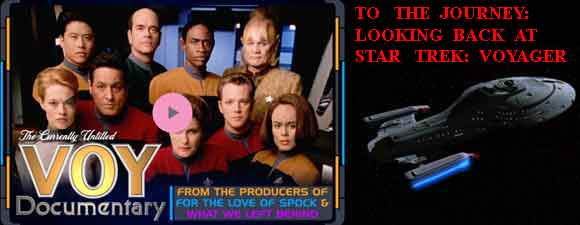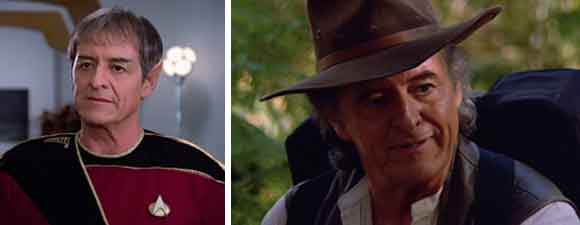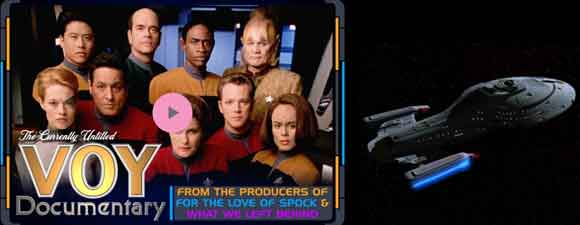Retro Review: Lifesigns
6 min read
lifesignsbanner
Voyager rescues a critically ill Vidiian woman who is given a holographic body by the Doctor while he treats her.
Plot Summary: Voyager picks up a distress call and rescues a dying Vidiian woman from the single passenger ship carrying her. Because she has a neural implant, the Doctor is able to create a holographic body for her while he treats her damaged brain tissue. The woman, Denara Pel, a doctor herself, has been ill with the phage since she was a child and is blissfully happy to look and feel healthy for the first time in her adult life. Though Torres is initially reluctant to save a Vidiian after the way they tortured her, she is sympathetic to Pel and agrees to donate her phage-resistant tissue. Kes realizes that the Doctor has developed romantic feelings for Pel and suggests that he tell her. The two share a pleasant evening in a holographic setting designed by Tom Paris, who advises the Doctor not to let Pel get away without expressing his feelings. Though Paris himself gets into serious trouble, acting defiantly toward Chakotay and ultimately being placed in the brig for violent behavior on the bridge, Paris allows the Doctor to use a holodeck program in which he and Pel share a kiss while parked in a historic car in a canyon on Mars. Meanwhile, Jonas reports to Seska on the apparent conflict between Chakotay and Paris, but becomes uncomfortable when she asks him to sabotage Voyager. As the Doctor prepares to transfer Pel’s consciousness back into her body, her condition worsens, and he discovers that she has attempted to poison herself because she would rather die in a holographic body than go on living in a diseased one. Persuading Pel that he will love her in her own body, the Doctor restores her to consciousness in her phage-wracked body and shares a dance with her before she departs to keep researching the disease that has decimated her race.
Analysis: Voyager had such a treasure in Robert Picardo. By definition, his character could only take center stage in “bottle” episodes – installments that were filmed entirely on regular sets, which in this case is limited to sickbay and the holodeck – so when the producers needed to save money, they wrote episodes around the Doctor. Instead of seeming poorer for the absence of location scenery, outer space visual effects, and lots of aliens, these are some of the finest episodes of the entire franchise, in large part because of the wonderful range and depth of emotion that Picardo gives the Doctor in the smallest of gestures. He never wastes a moment of screen time, he never looks bored tossing off technobabble. “Lifesigns” is a perfect example of what could have been a stagnant, talky storyline instead developing into a beautiful, emotionally satisfying drama. I’m sorry that the Kazon rather than the Vidiians were made into the principal villains during Voyager‘s early seasons because the Vidiians are a much more interesting culture, quite different from anything Star Trek has offered before, while the Kazon come across largely as less-developed Klingons. We’ve seen societies ravaged by disease on other Treks, but not a sophisticated civilization much like the Federation that has had to resort to the most vile measures merely to survive. We never find out whether there’s conflict among the Vidiians – whether we’re seeing the best and brightest of their scientists or the renegades who steal flesh while others choose death instead, whether they’ve attempted desperate measures like sending their children to be raised far from their parents and culture in the hope that they’ll escape infection. Would it count as saving the civilization if the children grew up disease-free, but with no first-hand knowledge of their culture? Does it count as saving the civilization if the entire species has had to resort to mass murder in search of a cure? What would Janeway do if it happened to her crew?
I’d have loved to explore such questions, but we only ever see the Vidiians in terms of how a handful of them affect Voyager – first forcing Janeway to decide whether to punish those who stole Neelix’s lungs, then splitting Torres into a separate Klingon and Human. “Lifesigns” is more about the Doctor’s journey than Pel’s, realizing that he can fall in love, taking another step in discovering the extent to which he can exceed his programming. Yet it’s Denara’s history to which more viewers will probably relate, whether it has to do with the fear of disease or of aging and becoming incapacitated. Her story dovetails with that of many chronically and terminally ill patients, particularly those with disfiguring illnesses. At the time the episode originally aired, AIDS was the obvious analogy – before more recent drugs became available, many patients suffered from cancers, sores, swellings, and weight loss that made them barely recognizable even to their loved ones – but there are parallels for people suffering from other diseases that distort and lay waste to healthy bodies, particularly for those caught in the awful position of needing an organ that will only become available for transplant in the event of the sudden death of a healthy person. As she tells Torres, Pel hates that her people have resorted to stealing from innocent, unwilling donors; she doesn’t beg Torres to save her life, she accepts that Torres may not be willing to help her. She’s afraid to explore her feelings for the Doctor, anticipating his rejection once she must return to her disease-ravaged body. The Doctor is afraid as well, but not for the reasons Pel imagines, since his understanding of her condition prevents him from feeling the horror or pity she anticipates. Apart from Kira and Odo, who also share radically different bodies, it’s almost unheard of even among Star Trek’s many species for people to experience attraction that isn’t in some part based on appearance.
While we’re being treated to the Doctor’s enviable ability to see Pel’s inner generosity and perception, which matter far more than any external signifiers of beauty, we’re also being shown the extent to which people will believe that surface traits define an individual as we watch Paris seemingly unravel. In retrospect, it’s apparent that Tom is overplaying the part, but I’ve never felt that the dramatic tension was very effective anyway because it isn’t unlike Voyager‘s writers to have a character make sudden excessive changes in service to a storyline that doesn’t really warrant it. That we’re expected to believe Neelix can essentially switch off his obsessive jealous about Kes and that we’re later expected to believe in Seven of Nine’s out-of-the-blue romance with Chakotay are just a couple of examples. No one likes being played for a fool, and the writers are playing the audience for fools, not letting us in on the plan to use Paris to expose Jonas’s treachery. Particularly on a rewatch, knowing that Janeway and Tuvok have set up the whole scheme with Paris and don’t trust Chakotay enough to include him, it’s really unpleasant to watch, not least because Paris is a far more interesting character when we can believe that he hasn’t completely conquered his self-doubts and resentments. No one, not even Torres or Kim, starts to wonder whether something else might be going on with Paris, which doesn’t say much for their friendships. I like the idea of a continuing storyline involving Seska and a traitor on board the ship, but the crew comes across as weak and immature – quite the opposite of the Doctor, who despite being very nearly a child emotionally is willing to take a leap and trust someone whose own emotional scars may leave him open to rejection and sorrow.







Robert Picardo is wonderful; I’m amazed at how he manages to make just about anything interesting and watchable. And he continues the wonderful Star Trek tradition of showing us the humanity in whichever character is supposedly the least human.
Yeah he makes SyFy movies almost watchable.
the show never did deal with the fact that Klingon dna could cure the vidiians.nso a potential story arc where they would be hunting the ship to get torres was never created.
It was Picardo and the actress that play Pel that carried this episode… they made it what it was.
I really shudder to think what Voyager would have been without Robert Picardo. He single handedly made the show watchable for me. He created one of the best characters in the franchise on arguably it’s weakest overall show.
nnI think there’s an implication, though not necessarily in this episode, that the Doctor and Denara shared more than a kiss. In “Message in a Bottle,” the Doctor tells the Andy Dick EMH, “I’ve even had sexual relations.” He may have been alluding to his romance with the Denara Pel hologram.
Apart from the superficial joys of the usual modern Trek trappings, the Doctor was the only thing that kept me interested in Voyager for any of its characters. Janeway was an uneven mess held together through sheer willpower by Kate Mulgrew, Torres got less interesting with every passing season as her promise went largely unfulfilled, Kes was never someone the writers knew quite how to use beyond being a very pleasant confidant and Tuvok was fiercely interesting… when his Vulcan nature was completely subverted by a plot machination.nOnce Seven of Nine arrived I was so grateful for everything she brought to the table, the show was hanging by a thread. It was a no brainer she and the Doctor would have some of the best scenes on the show from then on. “Someone to Watch Over Me” was the highlight for me.